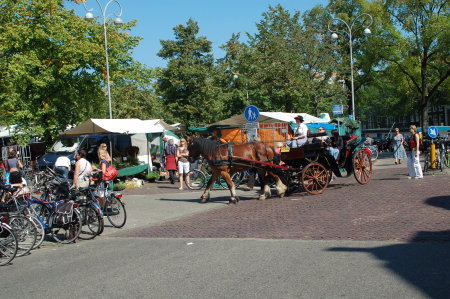
I’ve been meaning to post some pictures of our local Saturday farmer’s market for some time now. Last Saturday I took my camera along. Honestly it’s mostly locals who shop at this market, and someone with a camera really stands out and kind of gets in the way, which is why I haven’t made this post earlier. Above is a picture of the entrance. Everything sold at this market is supposed to be organic, but much of it is not certified. As far as I know, there is only one other organic market in the city, and mine is the only true farmers market as the other is simply run by independent market stand operators.
The horse was just dumb luck. We don’t normally have horses at the market. There are however a couple of horses that ride around the city giving rides and tours to tourists, and just as I picked up my camera one went past the market. A photo moment!
This market has a Dutch language website here. You might have some luck using Google language tools to translate it.
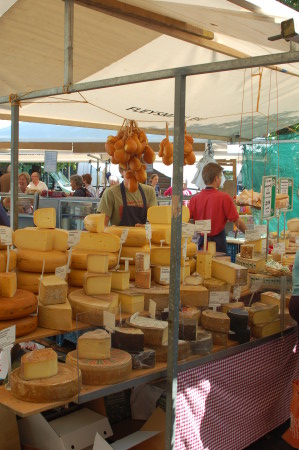
Above is my favorite cheese stand. They are a farm, and they do sell some of their own cheese. Mostly what they have done is collect organic artesian cheeses from small farms around Europe, and sell them. They are really expensive, but also have some very nice cheese.
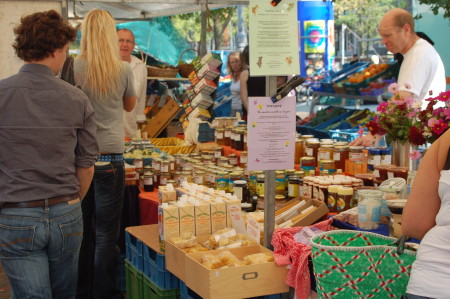
The honey guy (above) is usually there, selling honey and honey related products.
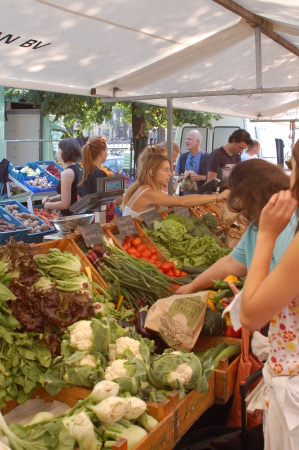
There are only about 4 or 5 stands selling vegetables regularly, and this is one I like because it’s reasonably priced and of good quality. This market is actually on the small side, when all is said and done.
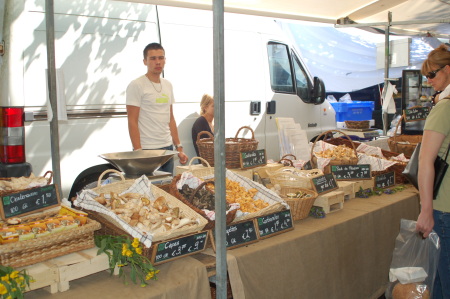
The most exotic stand there sells only mushrooms. Besides being very expensive, I honestly haven’t found much use for them. I like mushrooms, but I don’t really know how to cook most of these.
Besides these stands, others sell fruits and juices, grains, house plants, cheese, olives, breads and meats. Almost all the food related stands have farms behind them, but often sell other products that aren’t their own. There’s a stand that sells vegetarian goodies like handmade sushi, pate, sandwiches and so on. On the back side there are stands selling things like clothes and household things. There’s a woman who runs a Scottish baked goods stand, and there is a power foods stand where you can stock up on wheat grass juice and goji berries. Other stands come and go, and I’m sure I’ve forgotten a few.
I guess what I don’t like are the many non farmer’s market aspects to this market. Many stands sell things that aren’t their own, and these things often come from far away. I saw oranges this week, and these must have come from the southern hemisphere. I was hoping to get a picture of some the the large bunches of bananas that often adorn the market and must come from elsewhere, but there weren’t any this week.
You often see things like chestnut mushrooms, which all the food stands sell, all look exactly the same, cost about the same, and you know come from the same wholesaler.
While I sometimes appreciate being able to buy these things while I’m shopping at the market, and I have a lot of respect for the need for farms to work together because it’s pretty hard for one farm to provide enough variety year round to stock a single market stall by themselves, this really goes far beyond that. This is really a local farmers market, integrated with large scale food wholesalers. Also while I say local, many farms come from far away and are on the large side.
Also none of these farms offer Community Supported Agriculture subscriptions, at least via their market stalls. What sort of a true small farm would not choose to offer a CSA?
In fact, as far as I know, true CSAs are not available in Amsterdam. What we have here instead is the polar opposite, and it’s called a ‘Vegetable Subscription’. It’s run by the country’s largest organic produce wholesaler and is simply a selection of their choosing of all the leftover products that goes unsold through other channels. Real CSAs couldn’t compete with this on a price basis, and I think most Amsterdammers wouldn’t understand the difference, so it’s unlikely CSAs will take off here anytime soon.
What I just said about CSAs only applies to Amsterdam and probably most large Dutch cities. In the outlying areas I think there are lots of CSAs available, but I’m not really sure.







